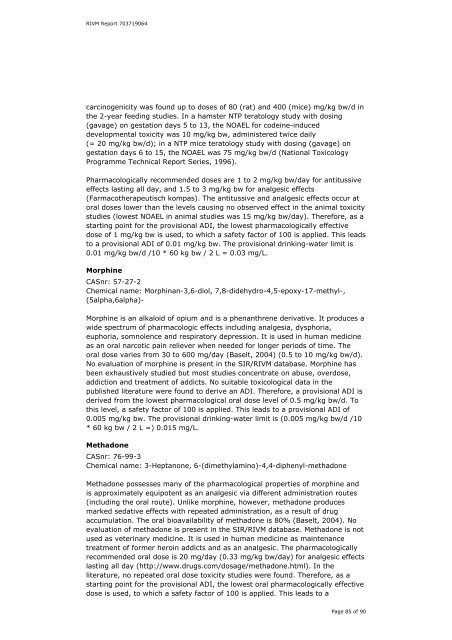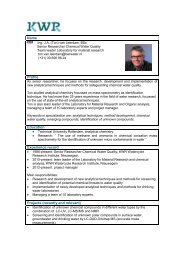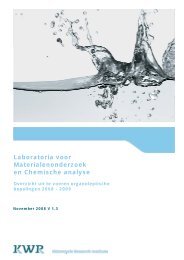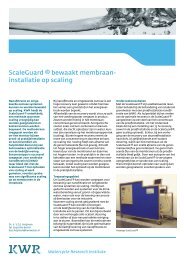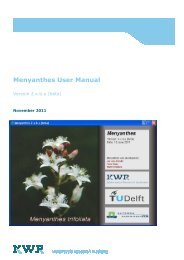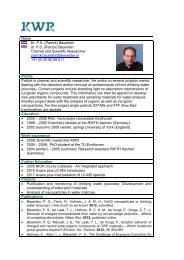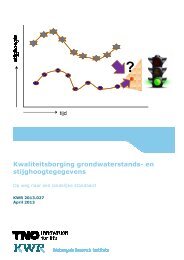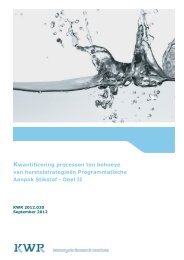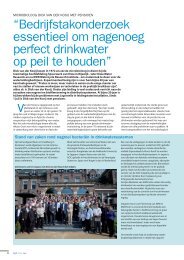Drugs of abuse and tranquilizers in Dutch surface waters, drinking ...
Drugs of abuse and tranquilizers in Dutch surface waters, drinking ...
Drugs of abuse and tranquilizers in Dutch surface waters, drinking ...
- No tags were found...
You also want an ePaper? Increase the reach of your titles
YUMPU automatically turns print PDFs into web optimized ePapers that Google loves.
RIVM Report 703719064carc<strong>in</strong>ogenicity was found up to doses <strong>of</strong> 80 (rat) <strong>and</strong> 400 (mice) mg/kg bw/d <strong>in</strong>the 2-year feed<strong>in</strong>g studies. In a hamster NTP teratology study with dos<strong>in</strong>g(gavage) on gestation days 5 to 13, the NOAEL for code<strong>in</strong>e-<strong>in</strong>duceddevelopmental toxicity was 10 mg/kg bw, adm<strong>in</strong>istered twice daily(= 20 mg/kg bw/d); <strong>in</strong> a NTP mice teratology study with dos<strong>in</strong>g (gavage) ongestation days 6 to 15, the NOAEL was 75 mg/kg bw/d (National ToxicologyProgramme Technical Report Series, 1996).Pharmacologically recommended doses are 1 to 2 mg/kg bw/day for antitussiveeffects last<strong>in</strong>g all day, <strong>and</strong> 1.5 to 3 mg/kg bw for analgesic effects(Farmacotherapeutisch kompas). The antitussive <strong>and</strong> analgesic effects occur atoral doses lower than the levels caus<strong>in</strong>g no observed effect <strong>in</strong> the animal toxicitystudies (lowest NOAEL <strong>in</strong> animal studies was 15 mg/kg bw/day). Therefore, as astart<strong>in</strong>g po<strong>in</strong>t for the provisional ADI, the lowest pharmacologically effectivedose <strong>of</strong> 1 mg/kg bw is used, to which a safety factor <strong>of</strong> 100 is applied. This leadsto a provisional ADI <strong>of</strong> 0.01 mg/kg bw. The provisional dr<strong>in</strong>k<strong>in</strong>g-water limit is0.01 mg/kg bw/d /10 * 60 kg bw / 2 L = 0.03 mg/L.Morph<strong>in</strong>eCASnr: 57-27-2Chemical name: Morph<strong>in</strong>an-3,6-diol, 7,8-didehydro-4,5-epoxy-17-methyl-,(5alpha,6alpha)-Morph<strong>in</strong>e is an alkaloid <strong>of</strong> opium <strong>and</strong> is a phenanthrene derivative. It produces awide spectrum <strong>of</strong> pharmacologic effects <strong>in</strong>clud<strong>in</strong>g analgesia, dysphoria,euphoria, somnolence <strong>and</strong> respiratory depression. It is used <strong>in</strong> human medic<strong>in</strong>eas an oral narcotic pa<strong>in</strong> reliever when needed for longer periods <strong>of</strong> time. Theoral dose varies from 30 to 600 mg/day (Baselt, 2004) (0.5 to 10 mg/kg bw/d).No evaluation <strong>of</strong> morph<strong>in</strong>e is present <strong>in</strong> the SIR/RIVM database. Morph<strong>in</strong>e hasbeen exhaustively studied but most studies concentrate on <strong>abuse</strong>, overdose,addiction <strong>and</strong> treatment <strong>of</strong> addicts. No suitable toxicological data <strong>in</strong> thepublished literature were found to derive an ADI. Therefore, a provisional ADI isderived from the lowest pharmacological oral dose level <strong>of</strong> 0.5 mg/kg bw/d. Tothis level, a safety factor <strong>of</strong> 100 is applied. This leads to a provisional ADI <strong>of</strong>0.005 mg/kg bw. The provisional dr<strong>in</strong>k<strong>in</strong>g-water limit is (0.005 mg/kg bw/d /10* 60 kg bw / 2 L =) 0.015 mg/L.MethadoneCASnr: 76-99-3Chemical name: 3-Heptanone, 6-(dimethylam<strong>in</strong>o)-4,4-diphenyl-methadoneMethadone possesses many <strong>of</strong> the pharmacological properties <strong>of</strong> morph<strong>in</strong>e <strong>and</strong>is approximately equipotent as an analgesic via different adm<strong>in</strong>istration routes(<strong>in</strong>clud<strong>in</strong>g the oral route). Unlike morph<strong>in</strong>e, however, methadone producesmarked sedative effects with repeated adm<strong>in</strong>istration, as a result <strong>of</strong> drugaccumulation. The oral bioavailability <strong>of</strong> methadone is 80% (Baselt, 2004). Noevaluation <strong>of</strong> methadone is present <strong>in</strong> the SIR/RIVM database. Methadone is notused as veter<strong>in</strong>ary medic<strong>in</strong>e. It is used <strong>in</strong> human medic<strong>in</strong>e as ma<strong>in</strong>tenancetreatment <strong>of</strong> former hero<strong>in</strong> addicts <strong>and</strong> as an analgesic. The pharmacologicallyrecommended oral dose is 20 mg/day (0.33 mg/kg bw/day) for analgesic effectslast<strong>in</strong>g all day (http://www.drugs.com/dosage/methadone.html). In theliterature, no repeated oral dose toxicity studies were found. Therefore, as astart<strong>in</strong>g po<strong>in</strong>t for the provisional ADI, the lowest oral pharmacologically effectivedose is used, to which a safety factor <strong>of</strong> 100 is applied. This leads to aPage 85 <strong>of</strong> 90


